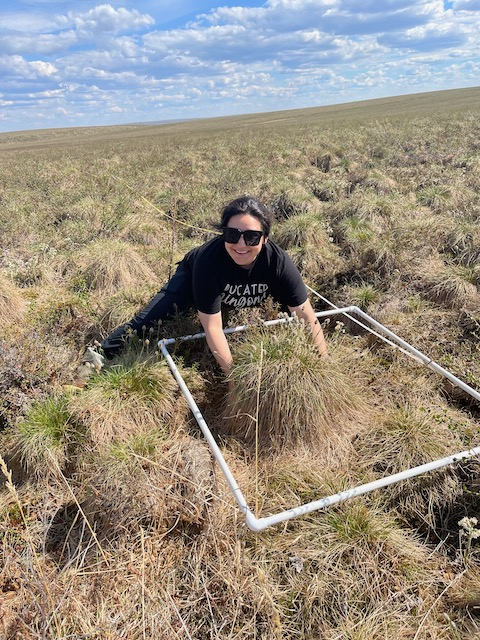One Fiery Day!
Yesterday, after a wonderful PolarConnect event, I headed out with Lexy Salinas to learn more about what she does while she’s up at Toolik. While Lexy grew up in the Rio Grande Valley, she’s recently been working on getting her master’s at Notre Dame, where she focuses on Arctic plant phenology. Her lab’s research focuses on the Anatuvuk Burn, a remote area that endured a major wildfire in 2007, and how the vegetation is regrowing in response to that wildfire.
Because the Anatuvuk Burn is in a remote area, we had to take a helicopter (more informally called “the helo” pronounced hee-low) out to the site, which meant I had to quickly go through helicopter safety training (the key is to avoid the blades at all costs, which means never go towards the back of the helicopter!). Robin, the helo coordinator, and Kirk, our pilot, walked me through everything I needed to know in order to enjoy the experience and not worry.
 The helicopter (aka "helo") that we took out to the burn! Photo taken by Lexy Salinas.
The helicopter (aka "helo") that we took out to the burn! Photo taken by Lexy Salinas.
Once we left Toolik, we headed out to the “Severe Burn” site. Naturally occurring wildfires aren’t uncommon in Alaska and they can ultimately end up improving the vegetation growth afterwards because they end up adding nutrients to the soil. That’s definitely what we found as we walked around counting Eriophorum (Tussock) flowers and taking spectral measurements, it was hard to find Tussocks that had less than 20 flowers on them!
 This tussock had so many flowers, I had to get a picture of Lexy with it!
This tussock had so many flowers, I had to get a picture of Lexy with it!
Kirk Vs. Bear
After the Severe Burn, we took a quick little ride over to the “unburned” part of the site. Lexy told me ahead of time that the difference between the sites would be obvious and it definitely was: this site had far fewer flowers on each tussock compared to the previous site.
But at this site, it wasn’t the flowers that were exciting, it was the wildlife. As Lexy and I were engrossed in counting flowers roughly 25 meters away from the helo, Kirk started shouting. We turned to see what the ruckus was, and noticed a huge bear approaching while Kirk bravely yelled at it trying to scare it away.
 Kirk yelling at the bear to scare it away. It got pretty close to him!
Kirk yelling at the bear to scare it away. It got pretty close to him!
 The bear from Kirk's point of view. Photo courtesy of Kirk Newmiller.
The bear from Kirk's point of view. Photo courtesy of Kirk Newmiller.
Although the bear seemed curious, it did eventually leave, and walked casually away towards a nearby lake. Lexy and I were in shock that we didn't notice the bear at all until Kirk started yelling, and so on our visit to the third and final site (the "moderate burn"), we made sure that our bear spray was out and ready, just in case!
 We also stopped to take some photos to prove that we had the bear spray! Photo by Lexy Salinas.
We also stopped to take some photos to prove that we had the bear spray! Photo by Lexy Salinas.
I did get a video of the bear and it has been posted on Instagram, so if you would like to see that, follow my account @theentropyreport.
On our helo ride back, Kirk ended up being our scout and finding different wildlife on the way back. First, we saw a small group of caribou. Then, more excitingly, we saw a momma bear with her two cubs on the side of a mountain. And finally, as we were fairly close back to camp, another lone bear that was along the river. Lexy and I were keeping a watch out, but Kirk found them every time and had no problem slowing down a little to let us get the good view.
Overall, the helicopter ride was fabulous and Kirk was an amazing pilot, so for this yelp review I’m giving a 13/10, could not recommend enough!
 Lexy and I at the end of an exciting day!
Lexy and I at the end of an exciting day!
Thank you!
Thank you for all who joined us for yesterday’s PolarConnect event! Sarah, Jeremy, and I had such a wonderful time sharing the science and the Arctic with you, and we were lucky that yesterday was such a lovely day outside! As I write this now, it has become a little cooler out and is overcast, so we definitely got lucky yesterday.
I am so grateful to be having this experience and know that there are so many supporters of myself and the team. Thank you all for being there for us!
If you want to share the event, or if you missed the event and want to watch it, all PolarConnect events are recorded and are posted on the PolarTREC website. You can click here to find all the PolarConnect events, including mine.


Comments
Add new comment